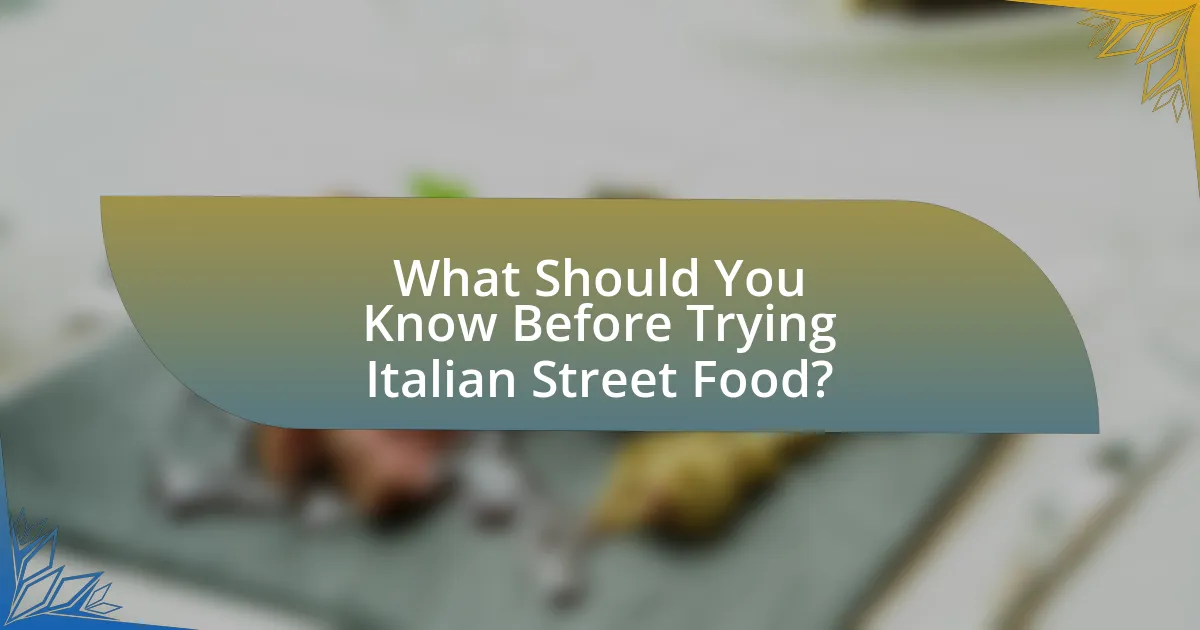Italian street food encompasses quick, affordable meals sold by vendors, deeply rooted in Italy’s regional flavors and traditional recipes. The article explores the evolution of Italian street food from ancient Rome to modern times, highlighting historical influences, regional variations, and key characteristics that define this culinary practice. It details must-try dishes such as arancini and pizza al taglio, while also providing insights on how to find authentic vendors, avoid tourist traps, and enhance the street food experience. The focus on local ingredients and preparation methods underscores the rich gastronomic identity of Italy, making street food an essential aspect of its culture.

What is Italian Street Food?
Italian street food refers to quick, affordable meals sold by vendors in public spaces, often characterized by their regional flavors and traditional recipes. This culinary practice has deep roots in Italy’s culture, with items like pizza al taglio, arancini, and panzerotti being popular choices. The significance of Italian street food lies in its ability to reflect local ingredients and cooking methods, making it a vital part of Italy’s gastronomic identity.
How did Italian street food evolve over time?
Italian street food evolved significantly from ancient Roman times to the present day, reflecting changes in culture, economy, and culinary practices. Initially, street food in ancient Rome consisted of simple items like bread, cheese, and olives, sold by vendors to cater to the working class. Over the centuries, the introduction of new ingredients from trade and exploration, such as tomatoes and spices, transformed the offerings. By the Middle Ages, fried foods and stuffed pastries became popular, with regional variations emerging across Italy. The 19th century saw the rise of iconic dishes like pizza and arancini, influenced by local ingredients and traditions. Today, Italian street food continues to evolve, incorporating modern culinary techniques while maintaining its roots in regional flavors and seasonal produce.
What historical influences shaped Italian street food?
Italian street food has been shaped by various historical influences, including regional agricultural practices, trade routes, and cultural exchanges. The agricultural diversity across Italy led to the use of local ingredients, resulting in distinct street food offerings in different regions. For example, the availability of seafood in coastal areas influenced dishes like arancini in Sicily, while the use of wheat in the north led to the popularity of focaccia. Additionally, trade routes established during the Roman Empire facilitated the exchange of spices and cooking techniques, further enriching Italian street food. The influence of various cultures, such as Arab, Greek, and Spanish, introduced new flavors and cooking methods, contributing to the evolution of street food in Italy.
How do regional variations impact Italian street food?
Regional variations significantly impact Italian street food by influencing the ingredients, preparation methods, and flavors unique to each area. For instance, in Naples, street food prominently features pizza, particularly the iconic Neapolitan pizza, which is characterized by its soft, chewy crust and simple toppings like tomatoes and mozzarella. In contrast, Sicilian street food showcases arancini, rice balls filled with various ingredients, reflecting the island’s agricultural bounty and diverse culinary influences. Additionally, regions like Emilia-Romagna are known for their focus on cured meats and cheeses, leading to street food offerings such as piadine, flatbreads filled with local delicacies. These regional specialties not only highlight local produce but also preserve cultural traditions, making Italian street food a vibrant tapestry of Italy’s culinary heritage.
What are the key characteristics of Italian street food?
Italian street food is characterized by its simplicity, regional diversity, and emphasis on fresh, high-quality ingredients. This cuisine often features portable dishes that are easy to eat on the go, such as pizza al taglio, arancini, and panini. Each region of Italy contributes unique flavors and traditional recipes, reflecting local agricultural products and culinary customs. For example, Sicilian street food includes specialties like sfincione, a thick pizza topped with onions and tomatoes, while in Naples, the iconic pizza is a staple. The focus on seasonal ingredients and traditional cooking methods ensures that Italian street food remains authentic and flavorful.
What ingredients are commonly used in Italian street food?
Common ingredients in Italian street food include bread, cheese, tomatoes, olive oil, and various meats. Bread serves as the base for many dishes, such as panini and focaccia. Cheese, particularly mozzarella and pecorino, adds flavor and texture to items like arancini and pizza. Tomatoes are essential in sauces and toppings, while olive oil is frequently used for drizzling and frying. Various meats, including prosciutto, salami, and sausages, are integral to many street food offerings, providing protein and richness. These ingredients reflect the traditional flavors and culinary practices of Italy, making them staples in the vibrant street food culture.
How does the preparation method affect the flavor of Italian street food?
The preparation method significantly influences the flavor of Italian street food by altering the texture, aroma, and taste profile of the ingredients used. For instance, frying enhances the crispiness and richness of items like arancini and zeppole, while grilling imparts a smoky flavor to skewered meats and vegetables, such as porchetta. Additionally, slow-cooking methods, like braising, allow flavors to meld and deepen, as seen in dishes like lampredotto. The choice of preparation technique directly impacts the final sensory experience, making it a crucial factor in the overall enjoyment of Italian street food.

What are the Must-Try Dishes in Italian Street Food?
The must-try dishes in Italian street food include Arancini, which are fried rice balls typically filled with ragù, mozzarella, and peas; and Panzerotti, a type of fried pastry filled with tomato and mozzarella. Additionally, Cicoria Ripassata, sautéed chicory often served as a side dish, is popular. Another essential dish is Porchetta, a savory, herb-stuffed roast pork served in a sandwich. These dishes reflect regional flavors and cooking techniques, showcasing Italy’s rich culinary heritage.
What are the most popular street food items in Italy?
The most popular street food items in Italy include pizza al taglio, arancini, and panzerotti. Pizza al taglio, or pizza by the slice, is a staple in Roman street food culture, characterized by its rectangular shape and variety of toppings. Arancini are fried rice balls, typically filled with ragù, peas, and mozzarella, originating from Sicily. Panzerotti, which are fried or baked dough pockets filled with cheese and tomato, are particularly popular in the southern regions of Italy. These items reflect Italy’s rich culinary traditions and regional diversity, making them essential for anyone exploring Italian street food.
What is Arancini and how is it prepared?
Arancini are Italian rice balls that are typically filled with ingredients such as meat, cheese, or vegetables, then coated in breadcrumbs and deep-fried until golden brown. To prepare arancini, cooked risotto is cooled and shaped into balls or cones, filled with the desired filling, then rolled in flour, dipped in beaten egg, and coated with breadcrumbs before frying. This method creates a crispy exterior while maintaining a flavorful and creamy interior, making arancini a popular street food in Italy.
What makes Pizza al Taglio unique?
Pizza al Taglio is unique due to its rectangular shape and the method of baking on a sheet pan, which allows for a thicker, airy crust. This style originated in Rome and is characterized by its variety of toppings and the ability to be sold by weight, making it a popular street food option. The dough is typically fermented for an extended period, resulting in a distinct flavor and texture that sets it apart from traditional round pizzas.
How do local specialties differ across Italy?
Local specialties across Italy differ significantly due to regional ingredients, culinary traditions, and historical influences. For example, in Naples, the iconic Neapolitan pizza is characterized by its soft, chewy crust and simple toppings, reflecting the local preference for fresh, high-quality ingredients like San Marzano tomatoes and mozzarella di bufala. In contrast, Bologna is renowned for its rich ragù alla Bolognese, a meat-based sauce that showcases the region’s emphasis on hearty, robust flavors and the use of local meats and vegetables. Additionally, Sicily offers unique specialties such as arancini, which are rice balls filled with various ingredients, highlighting the island’s Arab influences and abundant seafood. These regional variations illustrate how local specialties are shaped by geography, climate, and cultural heritage, making Italian cuisine diverse and regionally distinct.
What street food is famous in Naples?
The famous street food in Naples is pizza, specifically Neapolitan pizza. This iconic dish is characterized by its thin, soft crust and is traditionally topped with San Marzano tomatoes, fresh mozzarella, basil, and extra virgin olive oil. Neapolitan pizza has been recognized by UNESCO as an Intangible Cultural Heritage of Humanity, highlighting its cultural significance and historical roots in Naples.
How does Sicilian street food differ from that of Northern Italy?
Sicilian street food differs from that of Northern Italy primarily in its ingredients and flavors, reflecting the island’s unique cultural influences. Sicilian street food often features bold flavors, with a heavy emphasis on seafood, citrus, and spices, influenced by Arab, Greek, and Spanish culinary traditions. In contrast, Northern Italian street food tends to focus on richer, cream-based sauces, polenta, and meats, showcasing influences from Central European cuisine. For example, Sicilian arancini (stuffed rice balls) are commonly filled with ragù or peas, while Northern Italy is known for its panzerotti, which are often filled with cheese and tomato. This distinction highlights the regional diversity within Italian street food, shaped by historical trade routes and local agricultural practices.

What Should You Know Before Trying Italian Street Food?
Before trying Italian street food, it is essential to understand the regional diversity and authenticity of the offerings. Italy’s street food varies significantly from region to region, with each area showcasing local ingredients and traditional recipes. For instance, Sicilian street food features arancini (fried rice balls) and panelle (chickpea fritters), while in Naples, you might find pizza a portafoglio (folded pizza). Additionally, knowing the best times and places to sample street food can enhance the experience; many vendors operate during local festivals or markets, ensuring fresh and seasonal options. Understanding these aspects will help you appreciate the rich culinary culture behind Italian street food.
How can you find authentic Italian street food vendors?
To find authentic Italian street food vendors, explore local markets, food festivals, and popular street food districts in cities like Naples, Rome, and Bologna. These areas are known for their rich culinary traditions and often feature vendors who prepare traditional dishes using local ingredients. Additionally, seeking recommendations from locals or food bloggers can lead to discovering hidden gems that may not be widely advertised. According to the Italian National Institute of Statistics, street food is a significant part of Italy’s culinary culture, reflecting regional specialties and authentic flavors.
What signs indicate a quality street food vendor?
A quality street food vendor is indicated by high customer turnover, cleanliness, and the use of fresh ingredients. High customer turnover suggests popularity and trust, as seen in successful vendors who often have long lines. Cleanliness is crucial; vendors who maintain a tidy cooking area and use proper food handling practices demonstrate a commitment to food safety. Additionally, the use of fresh ingredients, often sourced locally, enhances flavor and quality, which is a hallmark of reputable street food vendors. These factors collectively ensure a positive dining experience and reflect the vendor’s dedication to quality.
How can you avoid tourist traps when seeking street food?
To avoid tourist traps when seeking street food, prioritize local recommendations and research popular spots frequented by residents. Engaging with locals can provide insights into authentic street food vendors, as they often know the best places that offer quality and traditional dishes. Additionally, using food apps or websites that focus on local cuisine can help identify highly-rated street food stalls that are not primarily aimed at tourists. According to a study by the University of Florence, locals tend to favor street food vendors that maintain high standards of hygiene and authenticity, which can guide tourists towards better choices.
What tips can enhance your Italian street food experience?
To enhance your Italian street food experience, prioritize trying local specialties from various regions. Each area in Italy offers unique street food, such as arancini in Sicily, panzerotti in Puglia, and supplì in Rome, which reflect local ingredients and culinary traditions. Engaging with street vendors can also enrich your experience; they often share stories about their food and its cultural significance, providing deeper insight into Italian gastronomy. Additionally, visiting food markets during peak hours ensures a vibrant atmosphere and fresher options, as many vendors prepare food on-site. This approach not only allows you to taste authentic dishes but also to immerse yourself in the local culture, making your street food journey more memorable.
How should you approach ordering street food in Italy?
To approach ordering street food in Italy, first, observe the local customs and practices at the food stall or truck. Italians often prefer to order in Italian, so learning basic phrases can enhance the experience. Additionally, it is common to stand at the counter while ordering, and many vendors may expect you to know what you want before reaching the front. This practice is rooted in the fast-paced nature of street food culture in Italy, where efficiency and familiarity with the menu are valued. Engaging with the vendor can also lead to recommendations, as they often take pride in their offerings.
What are the best times to enjoy street food in Italy?
The best times to enjoy street food in Italy are typically during lunch hours from 12 PM to 2 PM and in the evening from 6 PM to 10 PM. These time frames align with local dining customs, where Italians often take a break for lunch and enjoy leisurely dinners. Street food vendors are most active and offer a variety of fresh options during these peak hours, making it an ideal time for both locals and tourists to experience authentic Italian street cuisine.















